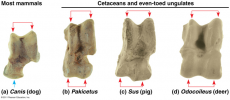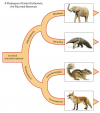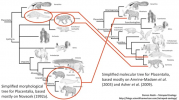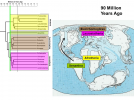Nesslig20
Active Member
Systematics has come a long way since the pioneer work of Linnaeus. More recently, a phylogenetic approach to systematics (called cladistics) now classifies organisms explicitly according to their ancestral relationships. Previously, taxa could be paraphyletic, polyphyletic or monophyletic, but now only monophyletic are considered legit.

Still, many taxa of the old linnean system have turend out to be monophyletic anyway, so these have for the most part much stayed the same. For example, mammals are still mammals in the same sense...furry tetrapods that produce milk to nourish their young...and they are monophyletic (sharing an exclusive common ancestral lineage). Although the odd monotrememes (platypus and echidna) were added, despite them laying eggs, which no therian mammal (placental+marsupial) does, and the definition has become a little bit more complicated than just "fur+milk" to accomodate the mammals that are only known from fossils, from which it's difficult to tell whether they had fur or produced milk. But at the very least, all marsupials, placentals and monotremes are still in the same group of mammals to the exclusion of anything else.
The same cannot be said for other lineages though. The famous one that many science savvy people is dinosaurs, which now includes birds, thereby making them dinosaurs as well. But there are many other instances which not many (at least to me) appreciate. Sometimes, these new classifications can be so counter intuitive that many find it difficult to accept them. Here are a few examples.
1. Birds are Reptiles
As I said like I said previously, birds are a subgroup of dinosaurs. But hold on...did it ever crossed your mind that since dinosaurs are a group of reptiles, this would logically mean that birds are reptiles as well? Yes, it does!! But it seems so strange to think of birds as reptiles, doesn't it? Even among those who will happily point out that birds are dinosaurs, I don't see many who will say (with the same enthusiasm) that birds are also reptiles. Oh wait, who am I to point fingers. I certainly don't say birds are reptiles just as frequently as birds are dinosaurs. And yet, the notion that birds are dinosaurs used to be considered just as strange.
The fact is that cladistics as welll as paleontology has effectively demolished our intuitive view of what a "reptile" is. When you think of a reptile, you are likely having an image of a cold-blooded, naked scaly creature that sprawls on its belly with four limbs (except if it was a snake). Something that looks like a lizard or a crocodile. Although...extinct reptiles include (non-avian) dinosaurs and many marine reptiles like ichthyosaur, plesiosaurs and mosasaurs, which don't fit neatly into that stereotypical mold. There are even strong indications that many non-avian dinosaurs and also ichthyosaur were "warm-blooded". If it were only extant reptiles, the stereotype mostly holds (although there are even living reptiles that thermoregulate to some degree). But even if we were to ignore the extinct reptiles, the fact that crocodilians share more recent ancestry with birds than they do with lizards already shows that excluding birds from the reptile group makes it paraphyletic. So what it means to be a reptile is now very different from what you are used to in every day life.
There are many videos that goes into more detail why birds are reptiles, but this below is my personal favorite.
2. Snakes are Lizards
...And so are mosasaurs..
Just like birds are dinosaurs, most science savvy people are aware that "snakes are tetrapods. Despite them having no legs, the ancestors of snakes were tetrapods with legs, so according to monophyly, snakes are still tetrapods regardless. But snakes are specifically squamates, i.e. lizards!! Lizards such as iguanas and varanids and even the extinct mosasaurs (yes, they are also lizards) are more closely related to snakes, then any of them are to other lizards like gekkos. This phylogeny below shows mosasaurs as among the closest to the snakes (serpentes), but there is still some controversy about the placement of mosasaurs. Nevertheless, snakes are firmly placed among the other lizards.
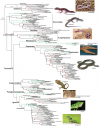
But snakes aren't simply legless lizards. There are many legless lizards that are not snakes, such as glass lizards and legless skinks. You can distinguish them from snakes with some key features.
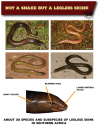
3. Whales are odd-toed hoofed mammals
Again, just like snakes, whales are still tetrapods, despite having lost some of their limbs. And most, even many laymen are aware that whales are marine mammals. But not many consider them artiodactyles, aka even-toed ungulate (i.e. hoofed) mammals. What on earth?!? TOED?? EVEN-TOED?!! HOOFED??!!! What are you talking about? Whales have flippers!! They don't have any toes, let alone an even number, let alone ones that are hoofed. But hold on. Whales are tetrapods, right? How can they be tretrapods without having four limbs?? It's because they descended from four-limbed ancestors. Likewise, they descended from even-toed ungulates and they are still even-toed ungulates. The closest living relatives of whales are hippos, and hippos are closer to whales than they are to any other even-toed ungulate.

The fancy name for even-toed ungulates is Artiodactyla and after it was found out that whales belong within this group, some tried to change the name from artiodactyla to "cetartiodactyla" putting a "cet" before the "artiodactyla" referring to the fancy name of whales "cetacea". Personally, I don't see the point. Like, we didn't rename "dinosauria" to "avedinosauria" when we found out birds (aves) are dinosaurs. Just keep the old name.
4. Butterflies are Moths
Butterflies and moths, seemingly as different as day and night...okay...poetry isn't my strong suit. But yeah, butterflies and moths seem so different, moths are active moslty at night while butterflies are active during the day.
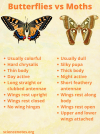
Although, there are a few moths that have more things in common with butterflies than other moths. So monophyly demands that butterflies are moths as well. This video by AronRa is the most comprehensive explanation of why butterflies are a subset of moths, but you can skip to 12:44 to the most important part.
5. Ants & Bees are Wasps
Now we consider three groups at the same time. Bees, ants and wasps. They are grouped together within "hymenoptera", along with sawflies (which itself is also paraphyletic. Which means that bees, ants and wasps are also sawflies too, but let's not make things too complicated). But while bees, ants and wasps are viewed as seperate groups, the former two nest within the latter. Ants are a group of flightless wasps, bees on the other hand are wasps that became vegetarian.
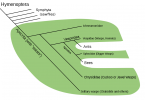
5. Insects are crustaceans
Insects belong to a larger group called "hexapoda" named after their 6 legged body structure. These are all terrestrial...well...mostly. On the other hand, crustaceans are all living in the water...well...mostly. We have the isopods like the woodlice (which are often mistaken as insects). But if insects are crusteaceans, does that mean they descended from somthing like lobsters, crabs, shrimp or crayfish? No. Most of these stereotypical crustaceans that you can probably think of at the moment...the ones that we enjoy eating...belong in a specific sub group of crustaceans called decapods. Hexapods (incl. insects) are not decapods. But there are other, more obscure crustacean groups, such as branchiopoda (which includes the triops, often called a "living fossil") that are more closely related to insects then to lobsters and crabs.
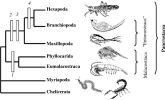
Similar to the previous whale example, in light of this realisation that insects are crustaceans, some have changed the name "Pancrustacea". The best I can say is that this name (with the "pan" meaning "total" put in front of it) is at least better than, say "hexacrustacea" or "insecrustacea", but still. Pancrustacea = crustacea.
6. Tetrapods (incl. us) are Fish
You know that guy who will correct someone who thinks that whales are fish. Well, they are actually right, whales are fish, but for a different reason that they think. It's not the fact that whales "look like" fish. Whales are tetrapods, and tetrapods turns out to be a subset of fish. Again, some fish are more closley related to tetrapods than other fish. I could give the full explanation here for why tetrapods are a subset of fish, but this video explains it best.
7. Humans are apes, but we already know that.
However, all apes including humans are also monkeys.
Calling a chimp a monkey at the zoo will likely attract that guy again who pointed out that whales aren't fish. Chimps are apes, they aren't monkeys. But there is something very interesting with the language that we use here. My primary language is dutch and we don't have a separate word for "ape" and "monkey". We use "aap" or "ape" (plural), which sounds close to the english word "ape", but the usage of the word "aap" in the dutch language is more equivalent to how "monkey" is used in english. Everything from howler monkeys, baboons, chimps and humans is an "aap". So when I try to translate the phrase "chimps aren't monkeys, they are apes" into dutch in my head, it is almost like it is saying (semantically) "chimps aren't monkeys, they are monkeys" or (phonetically) "chimps aren't apes, they are apes". This is of course very confusing when you are dutch and trying to learn primate taxonomy. To make a distinction, we have invented very weird combo words. We refer to all monkeys (including apes and humans) as "apen", but with "apes" (hominoids) we use "mensapen", which literally translates to "humanapes". Yes, combining the words (mens) "human" and "apes". Referring specifically to the great apes (hominids) we say "mensachtigen", which literally translates to "humanoids"
To put this in a table
Anyway, the notion that humans are monkeys is probably the most offensive to some people among the examples I have given here. Being an ape is already bad enough, why do we have to be monkeys too?!! Well, first, apes and monkeys are awsome. It is not a bad association. In some respects, it is more offensive to them to be associated with a species that has done so much ecological damage and enacted devastating wars, but I digress. In any case, apes are monkeys because some monkeys such as baboons (the old world monkeys) are more closely related to us than they are to the new world monkeys. In fact, we are also old world monkeys (the image has thus a slight error in this regard).
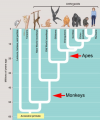
Again, a full explanation for this is given by Aronra in these two videos:
So yeah, you're a monkeyfish.

Still, many taxa of the old linnean system have turend out to be monophyletic anyway, so these have for the most part much stayed the same. For example, mammals are still mammals in the same sense...furry tetrapods that produce milk to nourish their young...and they are monophyletic (sharing an exclusive common ancestral lineage). Although the odd monotrememes (platypus and echidna) were added, despite them laying eggs, which no therian mammal (placental+marsupial) does, and the definition has become a little bit more complicated than just "fur+milk" to accomodate the mammals that are only known from fossils, from which it's difficult to tell whether they had fur or produced milk. But at the very least, all marsupials, placentals and monotremes are still in the same group of mammals to the exclusion of anything else.
The same cannot be said for other lineages though. The famous one that many science savvy people is dinosaurs, which now includes birds, thereby making them dinosaurs as well. But there are many other instances which not many (at least to me) appreciate. Sometimes, these new classifications can be so counter intuitive that many find it difficult to accept them. Here are a few examples.
1. Birds are Reptiles
As I said like I said previously, birds are a subgroup of dinosaurs. But hold on...did it ever crossed your mind that since dinosaurs are a group of reptiles, this would logically mean that birds are reptiles as well? Yes, it does!! But it seems so strange to think of birds as reptiles, doesn't it? Even among those who will happily point out that birds are dinosaurs, I don't see many who will say (with the same enthusiasm) that birds are also reptiles. Oh wait, who am I to point fingers. I certainly don't say birds are reptiles just as frequently as birds are dinosaurs. And yet, the notion that birds are dinosaurs used to be considered just as strange.
The fact is that cladistics as welll as paleontology has effectively demolished our intuitive view of what a "reptile" is. When you think of a reptile, you are likely having an image of a cold-blooded, naked scaly creature that sprawls on its belly with four limbs (except if it was a snake). Something that looks like a lizard or a crocodile. Although...extinct reptiles include (non-avian) dinosaurs and many marine reptiles like ichthyosaur, plesiosaurs and mosasaurs, which don't fit neatly into that stereotypical mold. There are even strong indications that many non-avian dinosaurs and also ichthyosaur were "warm-blooded". If it were only extant reptiles, the stereotype mostly holds (although there are even living reptiles that thermoregulate to some degree). But even if we were to ignore the extinct reptiles, the fact that crocodilians share more recent ancestry with birds than they do with lizards already shows that excluding birds from the reptile group makes it paraphyletic. So what it means to be a reptile is now very different from what you are used to in every day life.
There are many videos that goes into more detail why birds are reptiles, but this below is my personal favorite.
2. Snakes are Lizards
...And so are mosasaurs..
Just like birds are dinosaurs, most science savvy people are aware that "snakes are tetrapods. Despite them having no legs, the ancestors of snakes were tetrapods with legs, so according to monophyly, snakes are still tetrapods regardless. But snakes are specifically squamates, i.e. lizards!! Lizards such as iguanas and varanids and even the extinct mosasaurs (yes, they are also lizards) are more closely related to snakes, then any of them are to other lizards like gekkos. This phylogeny below shows mosasaurs as among the closest to the snakes (serpentes), but there is still some controversy about the placement of mosasaurs. Nevertheless, snakes are firmly placed among the other lizards.

But snakes aren't simply legless lizards. There are many legless lizards that are not snakes, such as glass lizards and legless skinks. You can distinguish them from snakes with some key features.

3. Whales are odd-toed hoofed mammals
Again, just like snakes, whales are still tetrapods, despite having lost some of their limbs. And most, even many laymen are aware that whales are marine mammals. But not many consider them artiodactyles, aka even-toed ungulate (i.e. hoofed) mammals. What on earth?!? TOED?? EVEN-TOED?!! HOOFED??!!! What are you talking about? Whales have flippers!! They don't have any toes, let alone an even number, let alone ones that are hoofed. But hold on. Whales are tetrapods, right? How can they be tretrapods without having four limbs?? It's because they descended from four-limbed ancestors. Likewise, they descended from even-toed ungulates and they are still even-toed ungulates. The closest living relatives of whales are hippos, and hippos are closer to whales than they are to any other even-toed ungulate.

The fancy name for even-toed ungulates is Artiodactyla and after it was found out that whales belong within this group, some tried to change the name from artiodactyla to "cetartiodactyla" putting a "cet" before the "artiodactyla" referring to the fancy name of whales "cetacea". Personally, I don't see the point. Like, we didn't rename "dinosauria" to "avedinosauria" when we found out birds (aves) are dinosaurs. Just keep the old name.
4. Butterflies are Moths
Butterflies and moths, seemingly as different as day and night...okay...poetry isn't my strong suit. But yeah, butterflies and moths seem so different, moths are active moslty at night while butterflies are active during the day.

Although, there are a few moths that have more things in common with butterflies than other moths. So monophyly demands that butterflies are moths as well. This video by AronRa is the most comprehensive explanation of why butterflies are a subset of moths, but you can skip to 12:44 to the most important part.
5. Ants & Bees are Wasps
Now we consider three groups at the same time. Bees, ants and wasps. They are grouped together within "hymenoptera", along with sawflies (which itself is also paraphyletic. Which means that bees, ants and wasps are also sawflies too, but let's not make things too complicated). But while bees, ants and wasps are viewed as seperate groups, the former two nest within the latter. Ants are a group of flightless wasps, bees on the other hand are wasps that became vegetarian.

5. Insects are crustaceans
Insects belong to a larger group called "hexapoda" named after their 6 legged body structure. These are all terrestrial...well...mostly. On the other hand, crustaceans are all living in the water...well...mostly. We have the isopods like the woodlice (which are often mistaken as insects). But if insects are crusteaceans, does that mean they descended from somthing like lobsters, crabs, shrimp or crayfish? No. Most of these stereotypical crustaceans that you can probably think of at the moment...the ones that we enjoy eating...belong in a specific sub group of crustaceans called decapods. Hexapods (incl. insects) are not decapods. But there are other, more obscure crustacean groups, such as branchiopoda (which includes the triops, often called a "living fossil") that are more closely related to insects then to lobsters and crabs.

Similar to the previous whale example, in light of this realisation that insects are crustaceans, some have changed the name "Pancrustacea". The best I can say is that this name (with the "pan" meaning "total" put in front of it) is at least better than, say "hexacrustacea" or "insecrustacea", but still. Pancrustacea = crustacea.
6. Tetrapods (incl. us) are Fish
You know that guy who will correct someone who thinks that whales are fish. Well, they are actually right, whales are fish, but for a different reason that they think. It's not the fact that whales "look like" fish. Whales are tetrapods, and tetrapods turns out to be a subset of fish. Again, some fish are more closley related to tetrapods than other fish. I could give the full explanation here for why tetrapods are a subset of fish, but this video explains it best.
7. Humans are apes, but we already know that.
However, all apes including humans are also monkeys.
Calling a chimp a monkey at the zoo will likely attract that guy again who pointed out that whales aren't fish. Chimps are apes, they aren't monkeys. But there is something very interesting with the language that we use here. My primary language is dutch and we don't have a separate word for "ape" and "monkey". We use "aap" or "ape" (plural), which sounds close to the english word "ape", but the usage of the word "aap" in the dutch language is more equivalent to how "monkey" is used in english. Everything from howler monkeys, baboons, chimps and humans is an "aap". So when I try to translate the phrase "chimps aren't monkeys, they are apes" into dutch in my head, it is almost like it is saying (semantically) "chimps aren't monkeys, they are monkeys" or (phonetically) "chimps aren't apes, they are apes". This is of course very confusing when you are dutch and trying to learn primate taxonomy. To make a distinction, we have invented very weird combo words. We refer to all monkeys (including apes and humans) as "apen", but with "apes" (hominoids) we use "mensapen", which literally translates to "humanapes". Yes, combining the words (mens) "human" and "apes". Referring specifically to the great apes (hominids) we say "mensachtigen", which literally translates to "humanoids"
To put this in a table
| Fancy taxonomic name | English name | Dutch name | Dutch name literally translated |
| Simiiformes (simian - simians) | Monkey - Monkeys | Aap - Apen | Semantic (Monkey - Monkeys) Phonetic (Ape - Apes) |
| Hominoidea (hominoid - hominoids) | Ape - Apes | Mensaap - Mensapen | Humanape - Humanapes |
| Hominidae (hominid - hominids) | Great ape - Great apes | Mensachtige - Mensachtigen | Humanoid - humanoids |
Anyway, the notion that humans are monkeys is probably the most offensive to some people among the examples I have given here. Being an ape is already bad enough, why do we have to be monkeys too?!! Well, first, apes and monkeys are awsome. It is not a bad association. In some respects, it is more offensive to them to be associated with a species that has done so much ecological damage and enacted devastating wars, but I digress. In any case, apes are monkeys because some monkeys such as baboons (the old world monkeys) are more closely related to us than they are to the new world monkeys. In fact, we are also old world monkeys (the image has thus a slight error in this regard).

Again, a full explanation for this is given by Aronra in these two videos:
So yeah, you're a monkeyfish.
Last edited:


